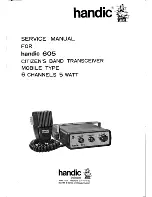
FCC ID: K66FT-857
Operating Manual
Vertex Standard Co., Ltd.
47
Pressing the [A](STO) key momentarily while in Multi Function Row “c” [STO, RCL, PROC] will also store a frequency
into the QMB register.
QMB Channel Recall
1. Press the [F] key momentarily, then rotate the MEM/VFO CH knob, as needed, until Multi Function Row “c” [STO,
RCL, PROC] appears on the display.
2. Press the [B](RCL) key momentarily to recall the QMB memory. “QMB” will appear at the upper left corner on the
display.
3. Press the [B](RCL) key once more to return to the previous frequency (either a VFO frequency or a Memory
channel).
If you move the DIAL knob or MEM/VFO CH knob while in the QMB mode, you can change frequencies as if you were
in a “VFO” mode. You also can change operating mode by pressing the MODE(<) or MODE(>) key. When this is done,
“MTQMB” will appear in the display, where “MT” represents “Memory Tuning.” Press the [B](RCL) key once more to
return to the originally-stored QMB frequency.
Memory Operation on “Regular” Memory Channels
Most Memory operation will be conducted in the “regular” memory registers. There are 200 memory channels available
for storage and recall of important frequencies.
Normal Memory Storage
1. Tune in the desired frequency, and set the operating mode and bandwidth. If this is an FM channel, set up any
required CTCSS/DCS and repeater shift configurations. Standard (default) repeater shifts do not require you to utilize
the “split” frequency memory technique, described later.
2. Press the [F] key momentarily, then rotate the MEM/VFO CH, as needed, until Multi Function Row “b” [MW, SKIP,
TAG] appears on the display.
3. Press the [A](MW) key momentarily to enter the “Memory Check” mode, which is used to find an unused memory
channel. The frequency stored (if any) on the current memory channel will be shown in the display. Rotate the
MEM/VFO CH knob to select the channel number on which you wish to store the current frequency data.
4. Press and hold in the [A](MW) key for one second until you hear a double beep; the second beep confirms that the
frequency information was successfully stored.
Split-Frequency Memory Storage
You can also store “Split” frequencies, such as when operating on a repeater system not utilizing a “standard” offset. This
















































